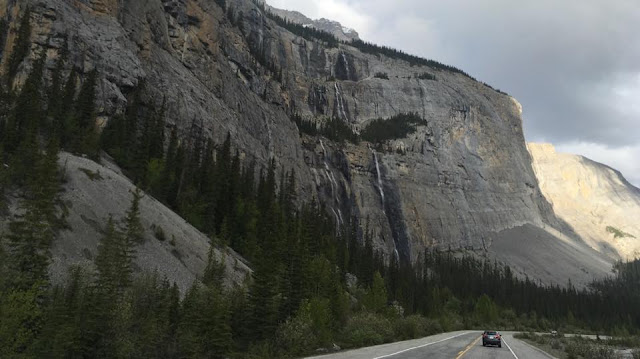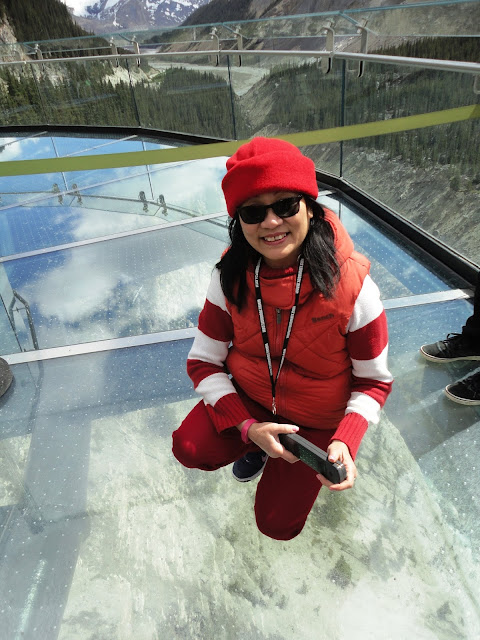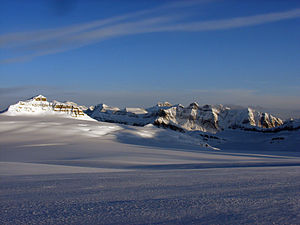Xe tuyết đầu tiên di chuyển trên băng đá Columbia
Xe đặc biệt " snow coach" giá 1 triệu 3 Canada


****************************************************
Columbia Icefield
From Wikipedia, the free encyclopedia
The Columbia Icefield is the largest ice field in the Rocky Mountains of North America.[1] Located in the Canadian Rockies astride the Continental Divide along the border of British Columbia and Alberta, Canada, the ice field lies partly in the northwestern tip of Banff National Park and partly in the southern end of Jasper National Park.[1]
Contents
[hide]Description[edit]
The Columbia Icefield is located in the Canadian Rockies astride the Continental Divide along the border of British Columbia and Alberta, Canada, the ice field lies partly in the northwestern tip of Banff National Park and partly in the southern end of Jasper National Park.[1][2] It is about 325 square kilometres (125 sq mi) in area, 100 metres (330 ft) to 365 metres (1,198 ft) in depth and receives up to 7 metres (280 in) of snowfall per year.[2]
History[edit]
The Columbia Icefield was formed during the Great Glaciation, or Illinoisan period (238,000 to 126,000 BC).[3] The initial advancement of the ice field ended during the latter millennia of the Early Wisconsinan period (73,000 to 62,000 BC), around the time Homo sapiens began to appear on the earth.[3] The next major advance of the ice field occurred during the Late Wisconsinan period (18,000 to 9,000 BC), which marked the end of the major intercontinental land mass bridges.[3] During theCrowfoot Glacier advance (9,000 to 7,000 BC), humans learned farming and civilizations began to develop along the Tigris, Euphrates, and Nile rivers.[3] The last major period of advance occurred during the Little Ice Age, which lasted from about 1,200 to 1900 AD. Around 1800, the Athabasca Glacier peaked, then went through a period of recession, and then advanced again until 1840, when it began receding until the present day.[3]
The Columbia Icefield was one of the last major geological features to be discovered by man in western Canada, due to its isolation and harsh weather conditions.[4] In April 1827, Scottish botanist David Douglas was crossing Athabasca Pass—a major trading route located north of the Icefield—when he climbed one of the adjacent mountain peaks. He reported his first ascent in his journal, describing it to be 6,000 metres (20,000 ft) in height.[4] In the summer of 1884, geology professor Arthur Philemon Coleman explored the Great Divide fromBanff to Jasper in search of Douglas' giant peak.[4] While unsuccessful, he did discover the route that would become the Icefield Parkway.[4] In July 1898, British explorer J. Norman Collie and his friends Hugh Stutfield and Herman Wooley set off in search of Douglas' giants, equipped by the famous Banff outfitter Bill Peyto. On the morning of August 18, Collie and Wooley climbed the east side of Mount Athabasca, moved up the glacier when the ridge gave way to crumbling rock, and made their way to the summit, where they discovered an ice field that extended to almost every horizon.[4] Collie later wrote:
In 1900, former British clergyman James Outram came to the Canadian Rockies to recover his health after a nervous breakdown.[6] The following year he made the first ascent of Mount Assiniboine (3,618 m, 11,870 ft), then considered the "Matterhorn of the Rockies".[6] In 1902, Outram made ten first ascents of peaks over 3,050 metres (10,010 ft) and discovered four new mountain passes in the Columbia Icefield area.[6] Two of his first ascents in 1902 were Mount Columbia (3,747 m, 12,293 ft) and Mount Bryce (3,507 m, 11,506 ft), one of the most dangerous and difficult summits in the Rocky Mountains.[6]
Following World War I, other mountaineering firsts occurred. In 1923, American climbers James Munroe Thorington and W. S. Ladd joined Austrian guide Conrad Kain to summit the daunting North Twin Peak (3,731 m, 12,241 ft), Mount Columbia, and Mount Saskatchewan (3,342 m, 10,965 ft) in five days.[6] The following year, another American expedition led by William O. Field and guide Edward Feuz climbed both the North Twin Peak and the South Twin Peak (3,566 m, 11,699 ft) in twenty-four hours—a combined distance of about 60 kilometres (37 mi).[6] In 1927, A. J. Ostheimer discovered a new route to the North Peak Summit, made first ascents ofStutfield Peak (3,450 m, 11,320 ft) and Mount Kitchener (3,505 m, 11,499 ft), and became the first climber to traverse the Snow Dome(3,456 m, 11,339 ft) in thirty-six hours.[7] During his sixty-three-day visit to the Columbia Icefield, Ostheimer and his two companions walked over a 1,000 kilometres (620 mi) and climbed thirty peaks—twenty-five of which were first ascents.[8]
In March 1932, three men undertook a remarkable skiing journey from Jasper to Banff that covered about 500 kilometres (310 mi).[8]When Cliff White, Joe Weiss, and Russell Bennet reached the Columbia Icefield, they climbed to the summit of Snow Dome, and then made a downhill run descent of almost 3,000 metres (9,800 ft) which lasted for 50 kilometres (31 mi)—the longest continuous ski run in Canadian history up to that point.[9] Their accomplishment played a major role in generating worldwide interest in the Canadian Rockies.[9] Today, mountaineers and skiers from around the world come to the Columbia Icefield to explore some of the classic routes discovered by these early pioneers of mountaineering.[9]
Glaciers[edit]
The icefield feeds eight major glaciers, including:
- Athabasca Glacier
- Castleguard Glacier
- Columbia Glacier
- Dome Glacier
- Stutfield Glacier
- Saskatchewan Glacier
Parts of the Icefield are visible from the Icefields Parkway. The Athabasca Glacier has receded significantly since its greatest modern-era extent in 1844. During the summer months visitors to the area can travel onto the glacier in the comfort of large "snowcoaches". The Columbia Icefield is also a major destination for ski mountaineering in the winter months.
The icefield was first reported in 1898 by J. Norman Collie and Hermann Woolley after they had completed the first ascent of Mount Athabasca.
The Athabasca River and the North Saskatchewan River originate in the Columbia Icefield, as do tributary headwaters of the Columbia River.[10] As the icefield is atop a tripleContinental Divide these waters flow ultimately north to the Arctic Ocean, east to Hudson Bay (and thence to the North Atlantic Ocean), and south and west to the Pacific Ocean.[11]Hudson Bay, in some watershed divisions, is considered to be in the Arctic watershed, in which case this would arguably not be a triple continental divide point.
Mountains[edit]
Some of the highest mountains in the Canada Rockies are located around the edges:
- Mount Andromeda (3,450 m, 11,320 ft)
- Mount Athabasca (3,491 m, 11,453 ft)
- Mount Bryce (3,507 m, 11,506 ft)
- Mount Castleguard (3,090 m, 10,140 ft)
- Mount Columbia (3,747 m, 12,293 ft)
- Mount King Edward (3,490 m, 11,450 ft)
- Mount Kitchener (3,505 m, 11,499 ft)
- North Twin Peak (3,684 m, 12,087 ft)
- South Twin Peak (3,566 m, 11,699 ft)
- Snow Dome (3,456 m, 11,339 ft)
- Stutfield Peak (3,450 m, 11,320 ft)
See also[edit]
References[edit]
Citations[edit]
- ^ a b c "Columbia Icefield". Encyclopædia Britannica. Retrieved January 10, 2015.
- ^ a b "Columbia Icefield Area and the Athabasca Glacier". Jasper National Park. Parks Canada. Retrieved January 10, 2015.
- ^ a b c d e Sandford 1993, p. 23.
- ^ a b c d e Sandford 1993, p. 56.
- ^ Sandford 1993, pp. 56–58.
- ^ a b c d e f Sandford 1993, p. 58.
- ^ Sandford 1993, pp. 58–59.
- ^ a b Sandford 1993, p. 59.
- ^ a b c Sandford 1993, p. 60.
- ^ "Drainage Basins". The Atlas of Canada. 2009. Archived from the original on July 11, 2012. Retrieved January 10, 2015.
- ^ Huck, Barbara; Whiteways, Doug. "The Columbia Icefield and the Athabasca Glacier". In Search of Ancient Alberta. Heartland Associates. Archived from the original on February 8, 2005. Retrieved January 10, 2015.
Sources[edit]
- Fraser, Esther (1969). The Canadian Rockies: Early Travels and Explorations. Edmonton: M. G. Hurtig Ltd. ISBN 978-0-888-30115-4.
- Sandford, Robert W. (1993). The Columbia Icefield. Banff: Altitude Publishing. ISBN 978-1-551-53619-4.














































































Aucun commentaire:
Enregistrer un commentaire